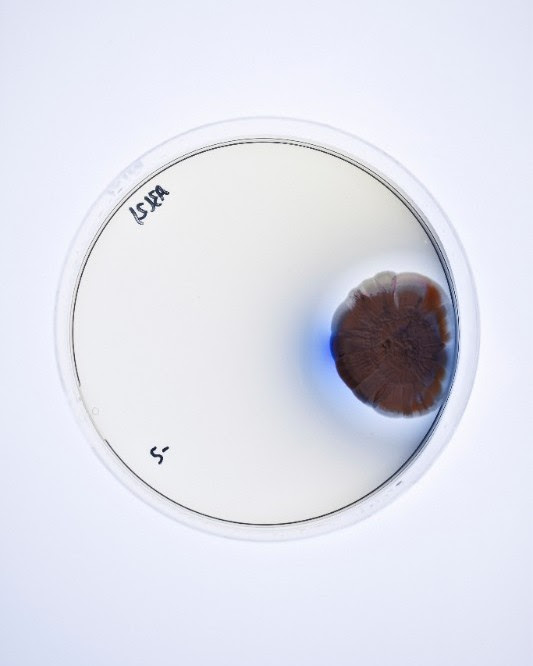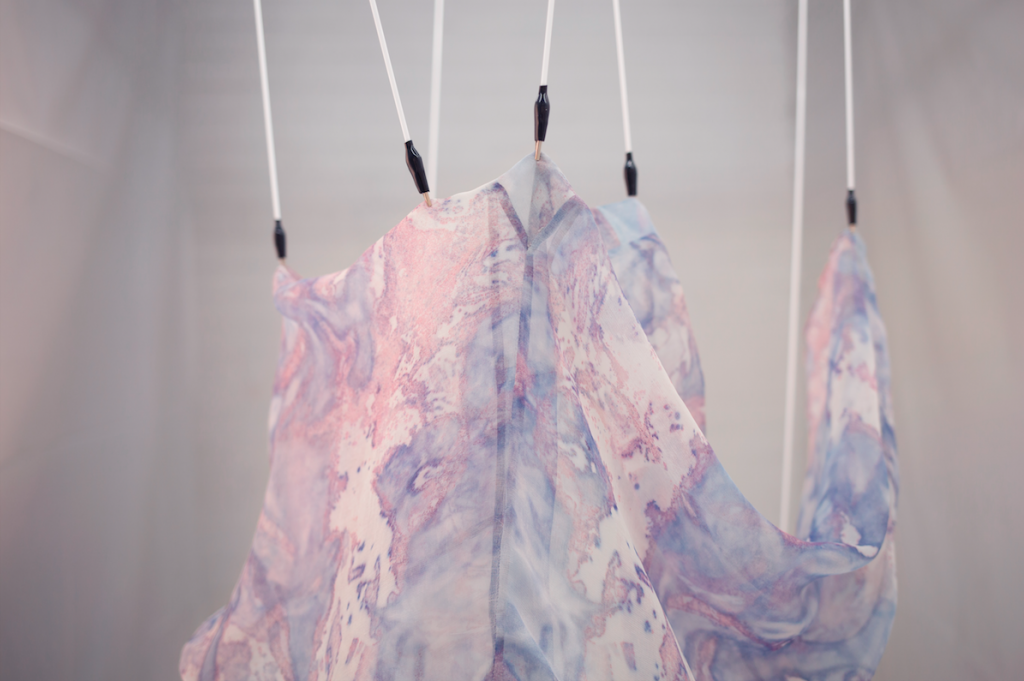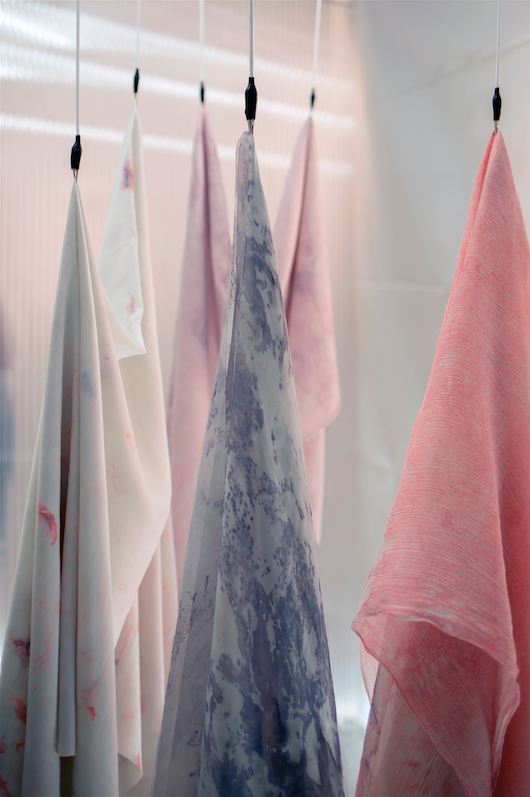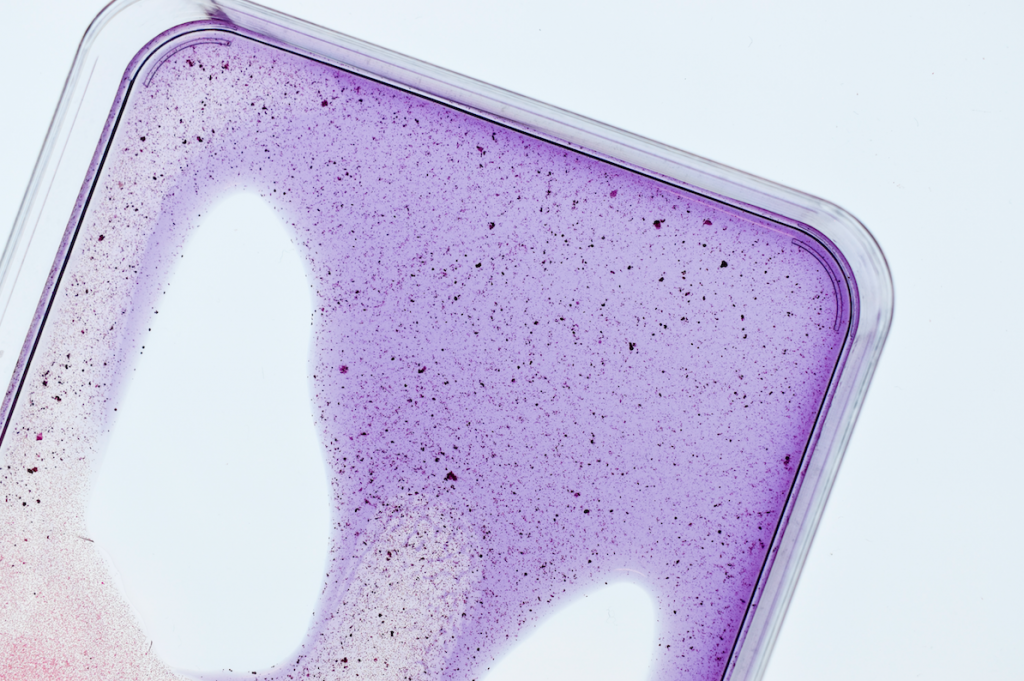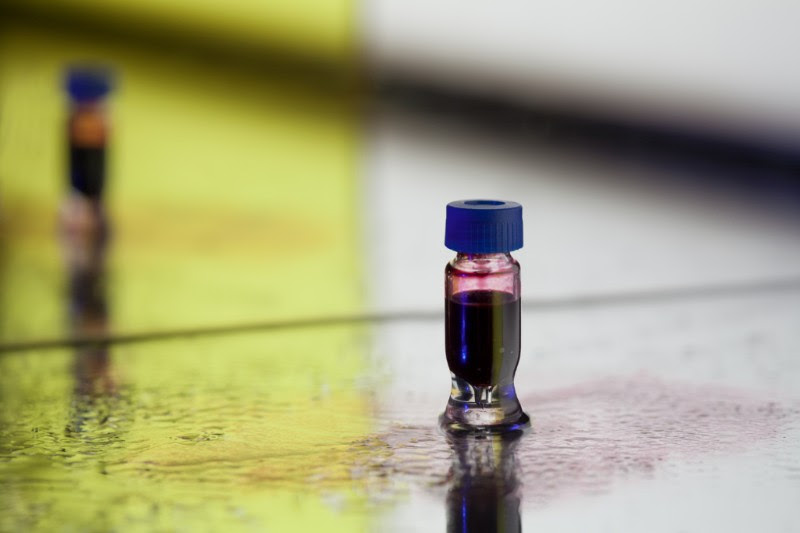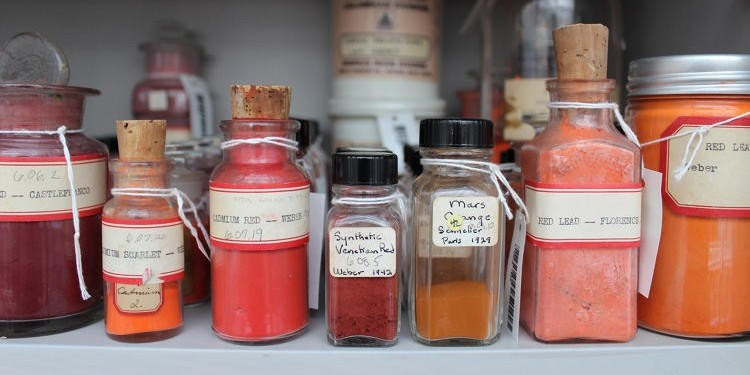A Bio Revolution: Faber Futures and Natsai Audrey Chieza
Natsai Audrey Chieza is pioneering a biofabrication revolution by co-creating with microorganisms and with ‘Faber Futures’, her bio-lab and consultancy
Millions of tiny blue and purple dots, like an incredibly fine mosaic of an inverted starry sky, cover the surface of a translucent piece of fabric. Both clustered and spread out the pattern is beautiful in its randomness. This intricate detailing and randomness is not the work of human hands but is, in fact, made by bacteria called Streptomyces coelicolor that dye the fabric. When these soil-dwelling organisms interact with protein fibers they produce a pigment that creates colorfast textile dyes without the use of chemicals and with substantially less water usage than fashion-industry textile processes.
Behind this seemingly miraculous process of biofabrication is Natsai Audrey Chieza who is pioneering a revolution in the world of design systems one small step at a time through bio-driven solutions. Since 2011, Chieza has been combining the fields of science and design alongside Professor John Ward of the Department of Biochemical Engineering, University College London. Together they have developed Project Coelicolor – a series of projects exploring the use of biopigments for textiles. Project Coelicolour is the result of nearly a decade of research “I have spent about eight years iterating on my design protocols to integrate S.coelicolor in the production of textiles, building the tools, choreographing the design methods, recording and building a real understanding of how you can co-create with living systems.” Chieza tells TLmag.
In tackling the hugely destructive environmental impact of the fashion industry – which she described in her TED talk of 2017 with poetic yet high-impact phrases such as our “denial of dependence” on fossil fuels and the West’s “privilege of not being affected” – Chieza hopes to show the huge potential of what design can be used for and how systems can be reimagined and implemented at an industrial scale.
She tells TLmag that although this task is daunting, “it’s nihilistic to walk away. The question is: how do you tackle something? I see that very very daunting task as something that can be picked apart.”
Chieza credits her architectural background for this attitude: “I think my education in architecture really ingrained this sense that anything is possible. It’s just about the detail. We used to have to draw these detailed drawings of how a screw would fit into a concrete plinth, which would then screw into a large wall and so on. That tiny detail was so integral to the efficacy of the climatic conditions of the building. It was so integral to the concept and the aesthetic underpinning of the building; the materials; the local environment. Someone could say “it’s just a screw!” but it wasn’t, because when all of the parts fit together then you have this tangible thing. ”
It is from this perspective and optimistic outlook that Natsai Audrey Chieza recently founded Faber Futures, a biodesign lab and consultancy. The sector-agnostic consultancy has a range of activities “we provide really unique insights for people who are trying to understand what this field is. We help them to map out and build frameworks around sustainable futures as linked to biodesign and biofabrication”. Although young, Faber Futures already has “a host of different clients across different sectors.” In addition they have their lab where Chieza continues to experiment with colors and other processes. “That’s really where I love to be. That’s my making space, my studio.”
Eight years ago, when Chieza first started delving into the field of biodesign and molecular systems, there was only a small community pursuing this way of working and it focused on a low-level scale of production. However, recently, there has been a scale-up of biofabrication that sees it working at an industrial level that is capable of mass production. Chieza cites Bolt Threads and Modern Meadows as just two examples of companies who are scaling up laboratory experiments to production lines for a consumer goods market. Faber Futures aims to encourage and accelerate this growing community who look to working with nature rather than merely taking from it. “I think it’s an urgent mission for anyone who is in the business of circulating materials. Now that we are able to design living systems for them to produce materials, that kind of thinking need to lives at the heart of the new industry and be built up.”
A lot of what Faber Futures does is to foster collaboration across fields. “The value in collaboration cannot be understated, it is intrinsic. It cannot happen any other way.” Their philosophy is built on the idea that in facilitating cross-disciplinary interactions this “enables understanding so that it might enable a conversation, a collaboration, a partnership and so on. That’s the strategy.”
Faber Futures approaches this merging of expertise from many directions. Sometimes it is as simple as creating a glossary so that everyone understands each other and can have a conversation on the same level. Another way is through storytelling which Chieza passionately believes “is vital” to allow people to enter the complex world of science and foster education.
At other times Faber Future’s role goes to the core of truly understanding what each stakeholder can bring to the table. “There is a lot of value in design that is poorly understood. I think even in the design industry at times it is poorly understood. But if we look at how we start to communicate design thinking in the sciences there is this real sense that design could be integrated right from the start. How do we enable people to understand each other’s’ language and what do that language means in different spaces?”
Another space that Natsai Audrey Chieza has ventured into is the rainbow world of the Forbes Pigment Collection at Harvard Art Museums. Chieza describes it as “an incredible repository of beautiful stories about the history of color and pigment as related to art and life.” The vials and vials of colored pigments that line the shelves of the collection date as far back as 1000 BC. The newest addition to the library is Faber Futures’ Streptomyces coelicolor pigment. However Chieza went one step further than simply donating a pigment. Alongside Ginkgo Bioworks, a Boston-based organism-design company, the designer also embedded the metadata of the organism and instructions about creating the color into the DNA of the pigment. By writing the “label” in “the language of life” Faber Futures is contributing to a field of research that has the remarkable potential to store the entirety of the world’s data for at least 700,000 years in the space of a small wardrobe.
The fourth issue of MIT Media Lab’s Journal of Design and Science marks another recent achievement of Natsai Audrey Chieza who co-edited it with artist Dr. Alexandra Daisy Ginsberg. Their editorial approach was to counter the failure of imagination in biodesign which is a result of much of the research being concentrated in the Global West and restricted to academic spheres. To do this, they expanded the conversation to encompass projects from all over the world. This led them to talk to a farmer and activist in Zimbabwe, a molecular palaeontologist who looks at ancient DNA to understand how things evolve and a Hawaiian microbiologist among many others. “We have paired people who come from different backgrounds to have a conversation with each other to discuss how their fields interact with other biological design futures.”
The growing movement around biodesign, biofabrication and biology-driven solutions will take time and many contributors. Faber Futures is starting conversations and enabling action with as many different people as possible to shift how design is thought about. “Design is not happening in a vacuum. It’s not removed from politics, it’s not removed from the environment, it is not removed from ecology. It is part of all these things. The sooner we realize that the sooner these massive challenges that we face become challenges that can be tackled in a tangible way with the right kind of collaborative partnerships.”

